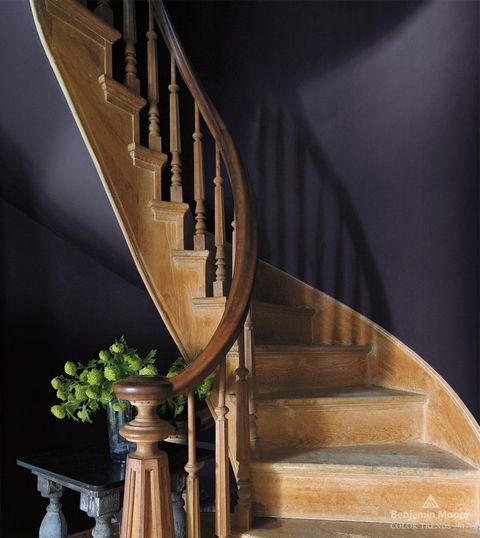Dark Wall Color Living Room
If you've been on Pinterest lately, you know that dark walls are in. Kitchens, dining rooms, powder rooms, and more are enrobed in rich shades from gray to navy to black. Benjamin Moore even announced Shadow 2117-30, a rich amethyst, as its Color of the Year.

Courtesy of Benjamin Moore
It's a daring, dramatic interior design decision, and it can definitely pay off. But there's a dark side to, well, going to the dark side: Deeper hues, while warm and cozy, can have the unwanted effect of making a room feel small or cave-like. They also heat up quickly in the sun—and that sunlight can cause fast fading. Plus, they're pretty unforgiving when it comes to imperfections (meaning you're going to see every lap mark and drywall chip) and can be difficult to touch up or paint over if you eventually decide you want to lighten up again.
Of course, there are plenty of positives to embracing bold hues in your home, and you shouldn't let the negatives scare you away completely. It's only paint, after all, so at the end of the day it's a pretty low-risk move that you can always go back on. And there ways to prevent the problems listed above.
This content is imported from Instagram. You may be able to find the same content in another format, or you may be able to find more information, at their web site.
Are you afraid of the dark? We spoke to Benjamin Moore Color and Design Expert Hannah Yeo about her best tips for decorating with dark paint.
1. Size doesn't matter.
"Don't let the size of a room stop you from using rich, bold colors," Yeo tells CountryLiving.com. "Deep colors blur the edges of walls, creating an illusion of an endless and expansive room. Stick to dark colors on the walls and lighter furnishings and linens to balance the room."
2. Add accents for dimension.
"Color often tricks the eyes to make the room look larger," Yeo says. "Whether it's a painted chair or a throw pillow, place a few bright-colored accents in a dark room. This redirects the focus to the forefront, allowing the walls to disappear, acting simply as a backdrop."
3. Low ceiling? Don't forget the trim!
"When using a dark color on walls with a low ceiling, paint the trim the same color as the walls. This hides the trim and makes the wall appear taller," Yeo explains, adding: "Place a mirror against the wall to add an illusion of depth."
4. Start small.
"Dark colors like Shadow 2117-30 can be a pop of color or act as a deep neutral depending on your home's lighting," Yeo says. "If you're intimidated by color, start small. Small rooms painted in these dark tones create a small jewel box in your home."
Taysha Murtaugh Lifestyle Editor Taysha Murtaugh was the Lifestyle Editor at CountryLiving.com.
This content is created and maintained by a third party, and imported onto this page to help users provide their email addresses. You may be able to find more information about this and similar content at piano.io
Source: https://www.countryliving.com/home-design/color/tips/a41828/dark-paint-problems-solutions/



0 Komentar